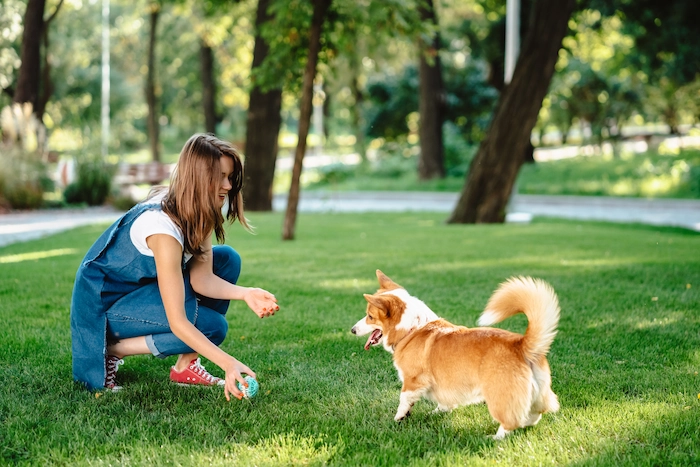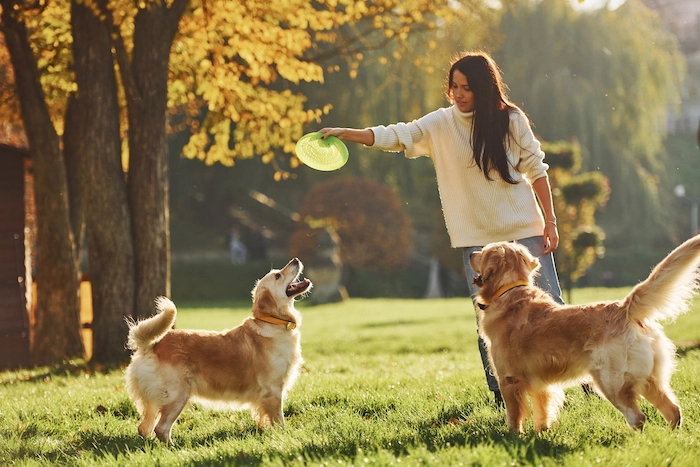Dogs are adventurous animals that love exploring their environment. However, their excitement can make them run into traffic, go to unfamiliar neighborhoods or encounter unfriendly strangers. As a result, loving dog owners have spent centuries trying to develop foolproof pet containment systems.
Traditional fences reinforced with thorns or barbed wire are commonly used to deter dogs from going beyond the safety of home. However, many pets can dig their way through the most unfriendly traditional fence and get lost.
The vulnerability and impracticality of a traditional fence led to the development of the first Invisible Fence® for dogs in the early 1970s. Over the years, the technology used in invisible dog fencing has become more friendly and effective, making invisible dog fence systems the tech-driven pet product of choice for 15% of dog owners.
But how does an Invisible Fence® work? Let’s look at the technical aspects of an invisible dog fence and see why the Halo Collar is the best invisible fencing you can get for your furry best friend.
The Mechanics Behind the Invisible Fence®
Early invisible in-ground wire fences used transmitters buried a few feet underground to send a radio signal to a collar the dog wears. The collar had prongs that would pass an electric shock through the dog when it got too close to the transmitters placed along a fence.
Current knowledge in dog psychology shows that fear and pain aren’t effective in protecting dogs. Modern invisible dog fences use different methods to keep dogs safe.
A modern wireless invisible or “virtual” fence uses the Global Positioning System (GPS) to interpret signals received from satellites orbiting Earth. The time a satellite’s signal takes to reach the GPS device in the collar provides its distance from the satellite. If the collar can access three or more satellite signals, the distance measurements produce its location.
A collar using the Global Navigation Satellite System (GNSS) can receive signals from out-of-network satellites, making it possible to pinpoint its location from anywhere on Earth more accurately than GPS.
The Halo Collar is an invisible dog fence that establishes your dog’s location using a GNSS receiver. A mobile app lets you control the collar, customize wireless dog fences and determine the right feedback for your pup.
Setting Up the Invisible Boundaries: The Concept of Virtual Fencing
One crucial Halo Collar feature is its ability to store multiple virtual fences.
You can make your invisible dog fence work by walking it along your home’s perimeter to let its GPS receiver communicate with satellites and create a boundary line around your home.
The Halo app, compatible with iOS and Android operating systems, provides a faster way of creating Halo Fences. The app’s map lets you set virtual posts around an area and store the fence line in your pup’s collar.
Other invisible dog fences work in ways similar to the Halo Collar. The SpotOn GPS Fence, for example, receives signals from around 128 satellites to provide a dog’s location and trajectory. In comparison, the Halo Collar’s GNSS allows it to receive signals from over 150 satellites, enhancing the accuracy of the location information stored in your pup’s collar. The Halo Collar’s strong reception also lets you set indoor fences to keep your dog out of specific rooms, a capability that a SpotOn receiver collar lacks.
Interactive Feedback Systems for Canine Safety
The receiver collar of an Invisible Fence® needs a feedback mechanism to stop your dog from going over the virtual fence.
Electric dog fences use physically painful and psychologically distressing electric shocks to discourage dogs from crossing a boundary wire. Moreover, the effectiveness of an electric fence is limited since you can only bury a wired fence in some places where you’re with your dog.
The Halo invisible dog fence collar uses sound, vibration and static feedback to keep your pup within a boundary zone. You can customize the feedback on the collar issues depending on what your dog responds to.
The collar can issue a sharp warning sound or vibrate to tell your pup it’s too close to the fence. You can also set a sound that tells your dog, “Turn back” or “Come home” when it crosses a boundary.
If your pup ignores the sound, static correction can pull its focus away from distractions by humans and other animals so it can stay within the fence. Unlike an electric shock, static correction is painless and feels like a touch or tap on the shoulder.

Training and Behavioral Conditioning
A virtual dog fence is only effective if your pup can identify and respond to the different feedback mechanisms. Cesar Millan’s dog training methodology is embedded into the fabric of the Halo Collar, providing the training required to make responding to feedback feel natural to your dog.
Initial training on the Halo app improves communication with your dog. You’ll learn the role of associative memory in how your pup learns and ways to model behavior for your pup to follow.
Further training helps you use treats and other incentives to generate your dog’s interest and trust in the collar. Eventually, your pup will associate the collar’s feedback with safety, making it easy to respond before it’s in danger.
Safety Protocols and Fail-Safes
The Halo Collar has several safety protocols to keep your pup safe. The first is an alert system that takes effect when your dog approaches a boundary.
A warning tone sounds when the dog is around 7 feet from the fence. If it ignores the tone, the collar produces a vibration boundary warning that escalates to an optional static correction once the dog passes the fence. All of the sounds, vibrations and static can be customized to what you and your dog prefer.
You can also teach your pup voice encouragement through the Halo app’s effective training process. Your pet will respond to the encouraging commands with proper training and return home. The system’s advanced algorithms can establish the dog’s direction, ensuring the collar doesn’t issue sound or static feedback when heading home.
Another Halo Collar fail-safe is the notification system. You’ll receive a phone notification when your pet disregards the alerts, with information on its location.
Choosing the Right Invisible Dog Fence
If you’ve only ever used a physical fence to keep your dog safe, trusting the Halo virtual fence may seem unreasonable. However, a GPS dog fence provides a clear advantage over traditional or electric fences.
For one, a Halo invisible dog fence costs less than a physical barrier, especially since it doesn’t require professional installation. The collars receive monthly updates, keeping your dog safe through the latest tracking technology.
The Halo Collar comes with the latest dog training modules and gives you access to top dog trainers at a very affordable monthly rate. The collar is also highly portable, keeping your dog safe in multiple locations.
Shop the Halo Collar invisible dog fence today to give your pup the safety to lead an adventurous life!










